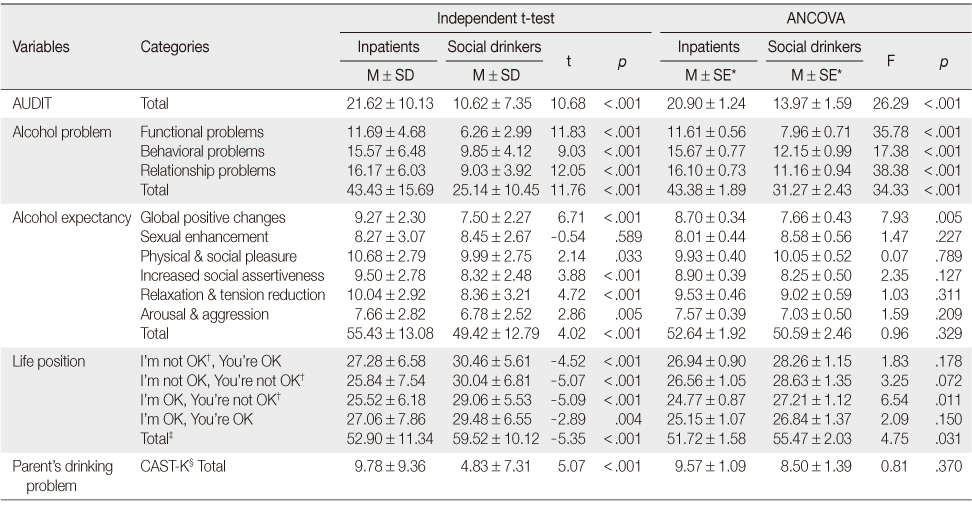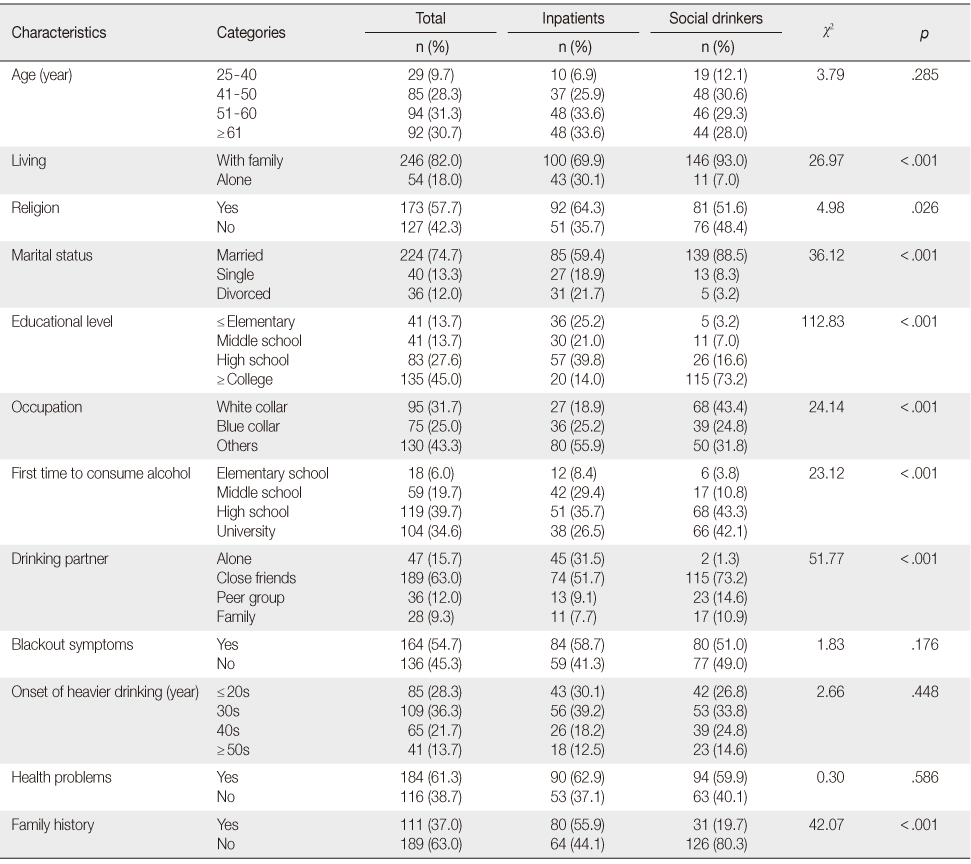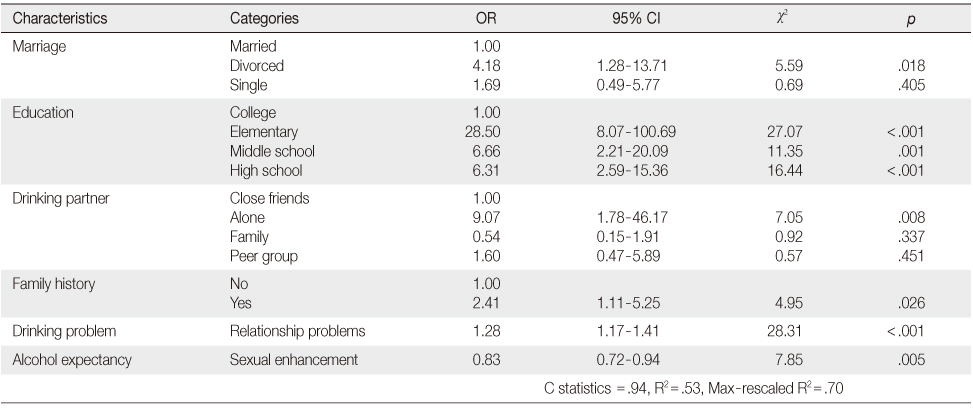Articles
- Page Path
- HOME > J Korean Acad Nurs > Volume 44(5); 2014 > Article
-
Original Article
- Predictors of Hospitalization for Alcohol Use Disorder in Korean Men
- Hae-Sook Hong, Jeong-Eun Park, Wan-Ju Park
-
Journal of Korean Academy of Nursing 2014;44(5):552-562.
DOI: https://doi.org/10.4040/jkan.2014.44.5.552
Published online: October 31, 2014
College of Nursing, Kyungpook National University, Daegu, Korea.
- Address reprint requests to: Park, Wan-Ju. College of Nursing, Kyungpook National University, 680 Gukchaebosang-ro, Jung-gu, Daegu 700-422, Korea. Tel: +82-53-420-4977, Fax: +82-53-421-2758, wanjupark@knu.ac.kr
© 2014 Korean Society of Nursing Science
This is an Open Access article distributed under the terms of the Creative Commons Attribution NoDerivs License. (http://creativecommons.org/licenses/by-nd/4.0/) If the original work is properly cited and retained without any modification or reproduction, it can be used and re-distributed in any format and medium.
Abstract
-
Purpose
- This study was done to identify the patterns and significant predictors influencing hospitalization of Korean men for alcohol use disorder.
-
Methods
- A descriptive study design was utilized. Data were collected using self-report questionnaires from 143 inpatients who met the DSM-5 alcohol use disorder criteria and were receiving treatment and 157 social drinkers living in the community. The questionnaires included Alcohol Use Disorders Identification Test (AUDIT), Alcohol Problems, Alcohol Expectancy Questionnaire (AEQ), Life Position, and The Korean version of the Children of Alcoholics Screening Test (CAST-K). Data were analyzed using descriptive statistics, t-test, χ2-test, F-test, Pearson correlation coefficients, and logistic regression with forward stepwise.
-
Results
- AUDIT had significant correlations with alcohol problems, alcohol expectancy, and parents' alcoholism. In logistic regression, factors significantly affecting hospitalization were divorced (OR=4.18, 95% CI: 1.28-13.71), graduation from elementary school (OR=28.50, 95% CI: 8.07-100.69), middle school (OR=6.66, 95% CI: 2.21-20.09), high school (OR=6.31, 95% CI: 2.59-15.36), drinking alone (OR=9.07, 95% CI: 1.78-46.17), family history of alcoholism (OR=2.41, 95% CI: 1.11-5.25), interpersonal relationship problems (OR=1.28, 95% CI:1.17-1.41), and sexual enhancement of alcohol expectancy (OR=0.83, 95% CI: 0.72-0.94), which accounted for 53% of the variance.
-
Conclusion
- Results suggest that interpersonal relationship programs and customized cognitive programs for social drinkers in the community are needed to decreased alcohol related hospitalization in Korean men.
This study was supported by the Basic Science Research Program through the National Research Foundation of Korea (NRF) funded by the Ministry of Education and Technology (No. NRF-2013R1A1A4A01004549).
- 1. Seoul National University College of Medicine. The 2011 epidemiological survey of mental disorders among Korean adults. Seoul: Ministry of Health & Welfare; 2011.
- 2. Chung W, Lee SM, Kim JY. Socioeconomic costs of alcohol drinking. Seoul: Jipmoon; 2009.
- 3. Lee H, Lee B, Lim JH, Choi M. The structural relations between problem drinking of Korean adults and related factors. J Korean Alcohol Sci. 2012;13(1):109–121.
- 4. Kim JS, Lee JK, Chung S. Meta-analysis of factors related to problem drinking. J Korean Alcohol Sci. 2013;14(2):1–18.
- 5. Ministry of Health & Welfare, Korea Centers for Disease Control and Prevention. Korea health statistics 2012: Korea national health and nutrition examination survey (KNHANESV-3). Seoul: Ministry of Health & Welfare; 2013.
- 6. Bandura A. Self-efficacy: Toward a unifying theory of behavioral change. Psychol Rev. 1977;84(2):191–215.ArticlePubMed
- 7. Kim S. A study drinking motives, self efficacy, drinking problem in male adults. J Korean Acad Psychiatr Ment Health Nurs. 2006;15(3):270–280.ArticlePDF
- 8. Suh KH, Cho EH. Sensation seeking and alcohol expectancies factors associated with problem drinking and motivation for alcohol use. J Korean Alcohol Sci. 2011;12(1):1–14.
- 9. Lee MR. The relationship between alcohol use and drinking problems among college students. J Korea Acad-Ind Coop Soc. 2012;13(10):4619–4628. http://dx.doi.org/10.5762/KAIS.2012.13.10.4619Article
- 10. Seo HS. A study on relation between life position and functional ego state of alcoholics. Trans Anal Psychol Ther. 2007;4(1):93–115.
- 11. Choi BJ. A study on the causes effecting on problem drinking: A survey of corrective education attendees on drinking problem [master's thesis]. Gyeongju, Uiduk University. 2012.
- 12. Shin HW. The effects of personality on drinking problems. Korean J Clin Psychol. 1999;18(1):105–122.
- 13. Hair JF Jr, Black WC, Babin BJ, Anderson RE. Multivariate data analysis. 7th ed. Upper Saddle River, NJ: Prentice Hall; 2010.
- 14. Babor TF, Higgins-Biddle JC, Saunders JB, Monteiro MG. AUDIT: The alcohol use disorders identification test: Guidelines for use in primary care. 2nd ed. Geneva, CH: World Health Organization; 2001.
- 15. Korean Academy of Addiction Psychiatry, National Alcohol Project Supporting Committee. Addiction treatment guidelines series: I . Alcohol use disorder. Seoul: Author; 2011.
- 16. Brown SA, Christiansen BA, Goldman MS. The alcohol expectancy questionnaire: An instrument for the assessment of adolescent and adult alcohol expectancies. J Stud Alcohol. 1987;48(5):483–491.ArticlePubMed
- 17. In: Allen JP, Wilson VB. editors. Assessing alcohol problems: A guide for clinicians and researchers. Bethesda: MD: U.S. Department of Health and Human Services; 2003.
- 18. Berne E. What do you say after you say hello?: The psychology of human destiny. New York, NY: Grove Press; 1972.
- 19. Jones JW. The children of alcoholics screening test: A validity study. Bull Soc Psychol Addict Behav. 1983;2(3):155–163.Article
- 20. Kim MR, Chang HC, Kim KB. Development of the Korean version of the children of alcoholics screening test (CAST-K): A reliability and validity study. J Korean Neuropsychiatr Assoc. 1995;34(4):1182–1193.
- 21. Yoo IS, Choi EM, Kwon HJ, Lee SG. Drinking pattern and nonfatal injuries of adults in Korea. J Korea Acad-Ind Coop Soc. 2012;13(4):1690–1698. http://dx.doi.org/10.5762/KAIS.2012.13.4.1690Article
- 22. Kim JH. A study on factors affecting problematic drinking of employees [master's thesis]. Jinju, Gyeongsang National University. 2005.
- 23. Whitfield CL. The Healing the child within: Discovery and recovery for adult children of dysfunctional families. Deerfield Beach, FL: Health Communications; 2006.
- 24. Lee JY. The effect of ego states and life positions on empathy in nursing students. Korean J Stress Res. 2012;20(2):113–122.
- 25. Kim JH. The college adjustment of adult children of alcoholics: Focused on moderating effect of protective factors. J Soc Work Pract. 2008;7:131–157.
- 26. Kim HS. The relationship between perceived parenting behavior and codependency in ACOAs of university students. Korean Rev Crisis Emerg Manage. 2013;9(4):83–102.
- 27. Ryu JS, Kang KH, Lee JH. Factors of problem drinking among Korean adults. J Korean Alcohol Sci. 2011;12(1):29–42.
- 28. Abbaszadeh A, Eskandari M, Borhani F. Changing the care process: A new concept in Iranian rural health care. Asian Nurs Res. 2013;7(1):38–43. http://dx.doi.org/10.1016/j.anr.2013.01.004Article
REFERENCES

*Mean values were estimated using least squared method, adjusted for living, religion, marital status, educational level, and occupation. first time of drinking, drinking partner, family history;
†Life position subtotal scores were calculated after reversed coding; ‡Life position total scores were calculated after reversed coding for negative items; §The Korean version of the Children of Alcoholics Screening Test; AUDIT=The Alcohol Use Disorders Identification Test.
Figure & Data
REFERENCES
Citations

- Associations among Addiction Risk, Life Satisfaction, Depression, and Suicidal Ideation in Korean Adults
Mi Nam Bae, Mihyoung Lee, Sihyun Park, Eun Jin Lee
Journal of Korean Academy of Psychiatric and Mental Health Nursing.2019; 28(2): 133. CrossRef - Structural Equation Model for the Analysis of Alcohol-related Problem of Alcohol Use Disorders
Hee Jung Son, Won Kee Lee, Young Shin Park, Hae Sook Hong
Journal of Health Informatics and Statistics.2017; 42(2): 192. CrossRef - One Year Clinical Correlates of EtG Positive Urine Screening in Alcohol-Dependent Patients: A Survival Analysis
Pablo Barrio, Silvia Mondon, Lídia Teixidor, Lluisa Ortega, Eduard Vieta, Antoni Gual
Alcohol and Alcoholism.2017; 52(4): 460. CrossRef - Factors Affecting Social Problem-solving Ability in Male Alcohol Dependent Patients
Mi Young Kim, Eun Kyung Byun
Journal of Korean Academy of Psychiatric and Mental Health Nursing.2016; 25(4): 316. CrossRef - Effect of alcohol consumption on peripheral bloodAlumethylation in Korean men
Dong-Sun Kim, Young Hun Kim, Won Kee Lee, Yeon Kyung Na, Hae Sook Hong
Biomarkers.2016; 21(3): 243. CrossRef
Demographic and Clinical Characteristics of Participants (N=300)
Comparisons of Study Variables between Inpatients and Social Drinkers (N=300)
*Mean values were estimated using least squared method, adjusted for living, religion, marital status, educational level, and occupation. first time of drinking, drinking partner, family history;
†Life position subtotal scores were calculated after reversed coding; ‡Life position total scores were calculated after reversed coding for negative items; §The Korean version of the Children of Alcoholics Screening Test; AUDIT=The Alcohol Use Disorders Identification Test.
Correlations among Study Variables (N=300)
AUDIT=The Alcohol Use Disorders Identification Test.
Predictors of Hospitalization by Multiple Logistic Regression Analysis (N=300)
*Mean values were estimated using least squared method, adjusted for living, religion, marital status, educational level, and occupation. first time of drinking, drinking partner, family history; †Life position subtotal scores were calculated after reversed coding; ‡Life position total scores were calculated after reversed coding for negative items; §The Korean version of the Children of Alcoholics Screening Test; AUDIT=The Alcohol Use Disorders Identification Test.
AUDIT=The Alcohol Use Disorders Identification Test.
 KSNS
KSNS
 E-SUBMISSION
E-SUBMISSION



 Cite
Cite

